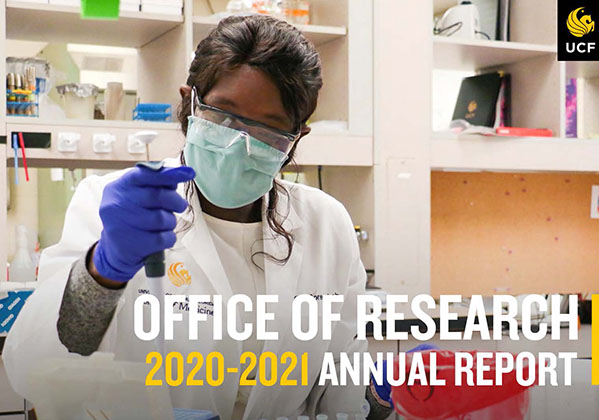Proposal Development Overview
Who can serve as Principal Investigator and Co-Principal Investigator?
A Principal Investigator ("PI") must be identified for every proposal submitted by the university. While there may be several co-Principal Investigators ("co-PI") or co-investigators ("co-I") involved in a proposal, there must be one individual who is recognized as responsible for the preparation, conduct, and administration of a research grant, cooperative agreement, training or public service project, contract, or other sponsored project.
Principal Investigator (PI) General Eligibility Requirements
Any of the following criteria must be met for an individual to serve as a PI:
- Full time faculty member currently employed by UCF
- A faculty member with emeritus status, with prior approvals from the College Dean or Division Head/Vice President, and Associate Vice President (AVP) for the Office of Research
- A post-doctoral employee at UCF
Special Circumstances:
- Graduate student employed by the university as either Graduate Teaching Assistants/Associates (GTAs), Graduate Research Assistants/Associates (GRAs), or Graduate Associates (GAs) can serve as a Principal Investigator for any fellowship authorized by the sponsoring agency; GTAs, GRAs, and GAs also may serve as Co-Principal Investigator on any grant or proposal being submitted with a member of the university community already authorized to submit proposals.
- Undergraduate students can serve as a Principal Investigator under a fellowship authorized by the sponsoring agency.
Exceptions
Persons other than full-time faculty may serve as principal investigators under certain circumstances with documented prior approval from their supervisor and co-signed by their Department Chair or Associate Dean for Research for their College.
The Department Chair must send an email to the Vice President for Research with a cc to the Proposal Administrator assigned to your area. Only the Vice President for Research can approve the authorization of the non-faculty individual's participation as a PI or Co-PI.
Approval from the VPR must be received and added as an attachment to the HRS Funding Proposal Record prior to proposal submission. Approvals will remain in effect for the approved individual unless it is officially rescinded by the Department Chair and/or Vice President for Research.
Note: This guidance is also applicable when an agency refers to the primary responsible person for a grant or contract by another title (e.g., Project Manager, Program Director, etc.).
Change in PI/PD
If a current PI severs his/her affiliation with UCF or otherwise relinquishes active direction of the project, s/he will notify the Office of Research of such change.
For additional information, contact the Office of Research Development or Office of Research Award Management.
Typical Sections of a Proposal
Table of Contents
This is a list of the proposal's major sections and corresponding page numbers. Most federal sponsors will provide a form to be used for the table of contents or provide guidance in the proposal guidelines. The table of contents should follow your proposal layout to help the reviewer identify key information used for the proposal evaluation.
Abstract/Executive Summary/Project Summary
This section is one of the most important! This section must be well written as it may be the first section reviewers read. Although this is one of the first pages of your proposal, it is usually prepared last. It is a brief, self-contained, ready-for-publication description of the project (not the proposal) objectives covering: (1) need and significance; (2) procedures; (3) evaluation; and (4) dissemination components. Some agencies ask you to write two abstracts: (1) layman terms and (2) scientific terms.
Purpose
This section gives a specific indication of the expected outcomes of the project, usually stated as goals and objectives, hypotheses, and/or research questions. It may explain how the project relates to the overall goals of a larger program. The purpose should clearly identify both expected short-term and long-term results.
- Goals provide overall conceptual orientation to the ultimate purpose of the project. They are abstract in content, broader in scope, less subject to direct measurement, and focused more on long-term perspectives.
- Specific Aims provide a succinct description of what specifically you plan to accomplish in your project.
- Objectives are more general than Specific Aims and describe what the research project plans to accomplish. They are more likely to be measurable and more likely to address short-term or intermediate accomplishments toward a goal.
- Hypotheses should be stated in such a way that they can be tested by securing information to judge truth or falsity. These should not be stated in the null form and should always be included wherever there is a basis for prediction.
- Research questions are generally used in lieu of hypotheses in exploratory studies or in projects of a survey research nature. Research questions should be phrased very specifically to indicate the exact nature of the proposed inquiry. The care with which the questions are selected and written will also demonstrate to the reviewer whether you have thought through a particular problem.
Statement of Need/Problem Statement
This is a well-documented description of the problem to be addressed and why it is important. This section should establish significance, timeliness, and contribution to related existing knowledge or work in progress. The statement of need should also address who will benefit from the research. This section should be succinct, yet persuasive.
Research Plan/Project Description/Procedures/Method
The Research Plan (or Research Strategy) is typically the longest section of the proposal. It is a detailed technical description of the project. It explains what it is and why it is important and should include sufficient information needed for evaluation of the project independent of any other document. This section is generally limited to 6 to 50 pages of text, figures, charts, and graphs and can vary depending on the sponsor and nature of the research. However, it usually includes a combination of the following subsections:
- Introduction � (usually reserved for revised or supplemental applications)
- Specific Aims and Objectives � a list of specific desired accomplishments and broad, long-term measurable objectives and goals of the research proposal
- Background and Significance � briefly sketch the background leading to the present application, critically evaluate existing knowledge, and specifically identify gaps that the project is intended to fill
- Preliminary Studies � outlines preliminary studies pertinent to the application as well as preliminary experience of project personnel
- Research Design & Methods � describe the research design conceptual or clinical framework, procedures, and analyses to be used to accomplish the specific aims of the research project
Other components of typical proposals include sections that address:
- Human or Animal Subjects � information pertaining to the participation of humans or use of vertebrae animals in the research project. There are usually a fixed set of questions to be answered
- Staffing/Equipment � describe who will participate and at what cost and what equipment purchase(s) will be essential
- Evaluation � describe the outcomes you hope to have in your project and timeline for completing each step
- Literature Cited � literature used in the background search as well as literature used in the body of the research plan
For information regarding development support services, please visit the Proposal Development Support webpage.
Page Sections
Serving Faculty
The Office of Research serves UCF scholars as the official liaison between UCF and funding sources and by helping faculty work through the proposal and contract management process.
This site includes information to assist university scholars through the announcement, application and post-award stages and to familiarize prospective partners with the breadth of funded research conducted at the university.
UCF is committed to the pursuit of excellence and intellectual growth and seeks to excel at moving ideas to innovation and realization. The Carnegie Foundation rates UCF as a "very high research activity" university. We�ve been on an upward trajectory for years and in 2021 UCF surpassed the $212.9 million dollar mark in external funding. UCF's pioneering efforts to commercialize technology continue to stimulate local economies throughout the state. The number of patents at UCF also continue to climb with 64 U.S. issued patents produced in 2021.
Budget Templates
Below you will find NIH and NSF budget templates. Although they are tailored for NIH or NSF, they can be used for developing your budget for any funding source.






